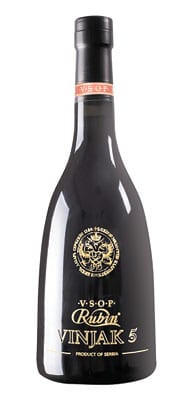Even after 60 years, Rubin’s Vinjak is recognised for its world-class quality, with hundred different awards, and its new special selection series, which was made to mark the jubilee
The Tri Morava region is located in central Serbia and covers an area of 286,930ha and nine vineyards, mainly characterised by moderately steep and gentle slopes and the fact that they are generally located at an altitude of 200 to 350 metres above sea-level, which enables the cultivation of top-quality grape varieties.
The Rubin Winery has a tradition dating back more than 60 years. In the last ten years, it has invested seriously in the expansion and renewal of vineyards and the introduction of modern technology. How big is the area currently occupied by Rubin’s vineyards?

– As a company, we are exceptionally committed to the quality and growth of the wine business, which is why our main preoccupation over the last decade has been an investment in the development of viticulture and the spreading of the wine culture in Serbia. Since 2008 we have acquired and planted over 800 hectares of vineyards, and today we have a total of 1,200 ha of vineyards.
We see the future in providing the raw materials for production from our own vineyards. With continuous growth, Rubin last year achieved annual production of more than 14 million litres of alcoholic beverages.
Rubin’s vineyards are located in the Tri Morava winegrowing region. What are the applicable attributes of that region and what are the most common varieties grown in your vineyards?
– In the development of viticulture, we are focusing on that part of central and southern Serbia, while our priority is the Tri Morava region, which is the location of our winery and the majority of our vineyards. Rubin mainly cultivates international varieties in its vineyards: Merlot, Chardonnay, Cabernet Sauvignon, Sauvignon Blanc, Muscat Ottonel, Rhine Riesling and Italian Riesling.
We are working intensively on planting the Prokupac indigenous variety. We have devoted a special aspect to the series of varietal wines that are currently Rubin’s fastest-growing brand. The range of these wines comprises three whites and three reds: Cabernet Sauvignon, Prokupac, Pinot Noir, Chardonnay, Sauvignon Blanc and Muscat Ottonel.
In creating these wines we were led by the idea of providing the market with something that reflects the serious work done in the vineyards and the winery.
We are currently developing the Vinjak Special Selection series, which will emerge as a result of the culmination of Rubin’s 60 years of experience in the production of vinjak. This is a blend of distillates that have aged in oak barrels for an unbelievable 30 to 50 years
You have been working intensively for many years on the revitalisation and progressive development of our autochthonous Prokupac variety?
– A rule of the winemaking world in developed countries is the correct selection of the assortment and work on choosing autochthonous varieties, so Rubin also turned towards the selection of varieties and the intensive planting of Prokupac and the production of wine from Prokupac.
We are expanding our Prokupac plantations every year and adjusting in accordance with the potential of vine grafts. In parallel with that, we are continuing to advance the wine potential of this variety through its clonal selection.
Vinjak is Rubin’s most popular authentic product, while its consistent quality has ensured the long-term loyalty of customers. What are your plans for Vinjak?
– Rubin Vinjak was created way back in 1957. And already by 1961, it had won its first prize, the Grand Prix in Ljubljana, and since then it has received hundreds of gold medals and championship trophies in international and domestic competitions.
Today we are working on the popularisation and promotion of vinjak brands Rubin VSOP and Rubin XO, which have been evaluated by foreign experts as being top world-class products.
To be the market leader for 60 years is a huge success, a success which, alongside the quality of Vinjak, must be attributed to its loyal customers, employees and Serbia.